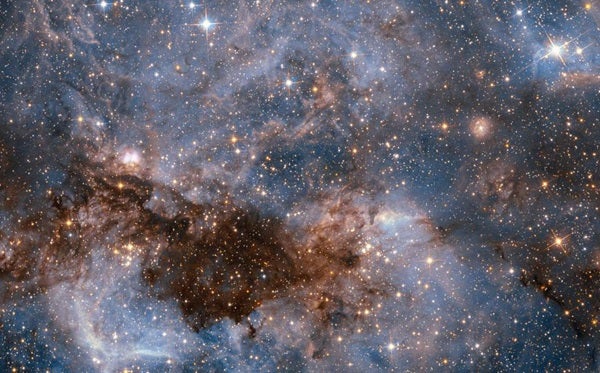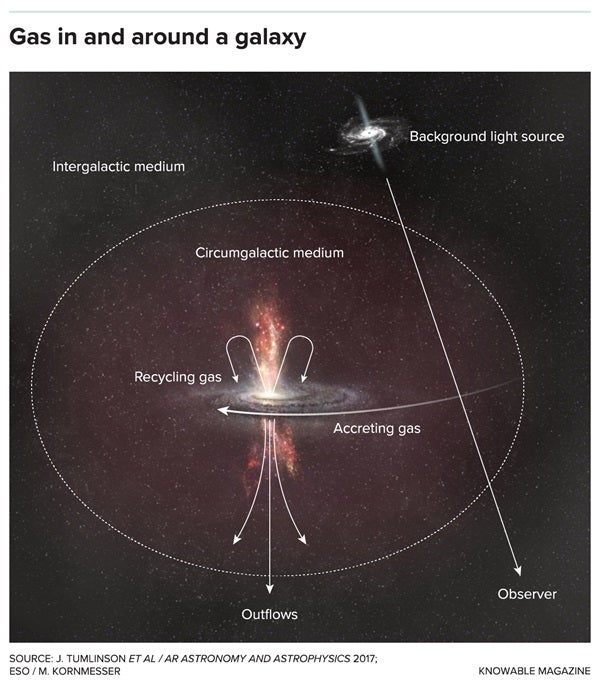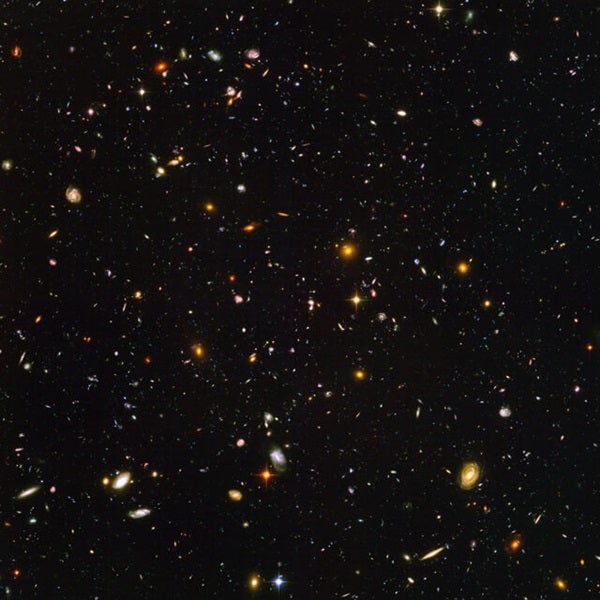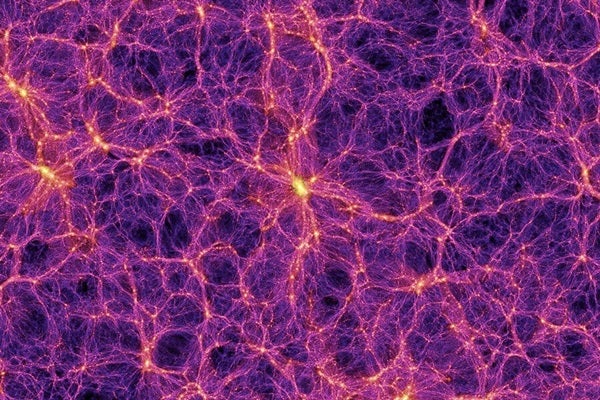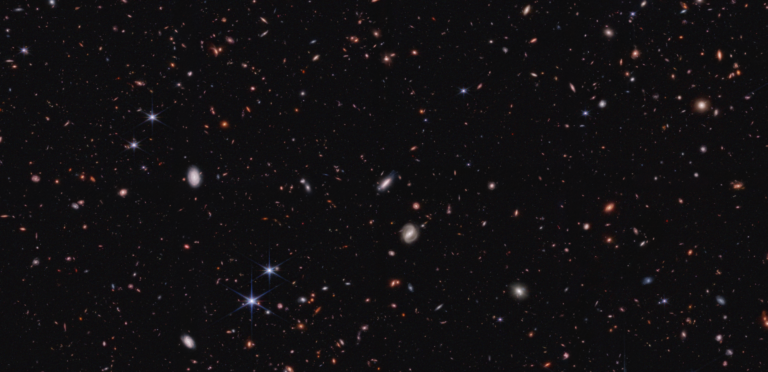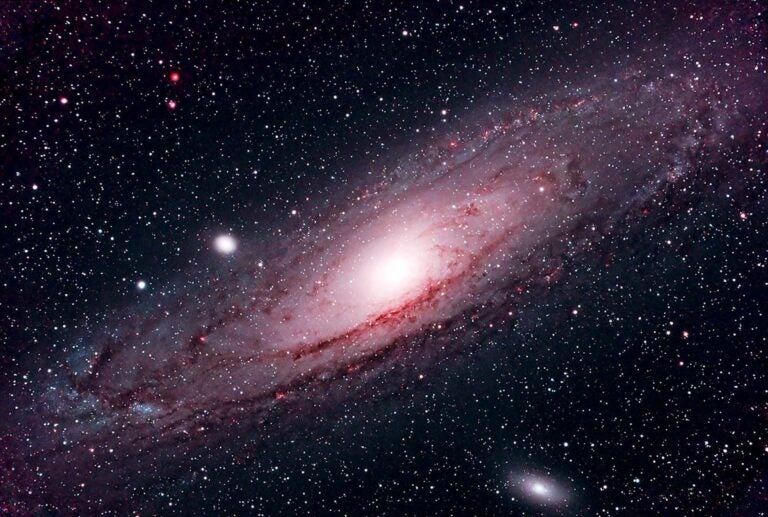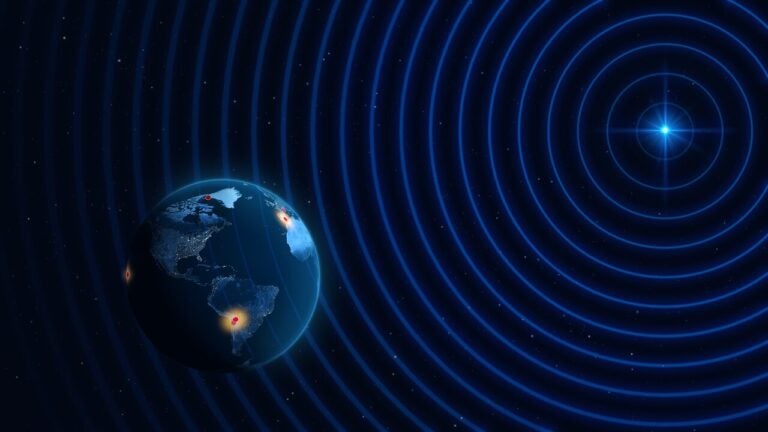Most of what astronomers know about the universe comes from what they can see. So their ideas have been prejudiced toward stars and galaxies, which are bright. But most of the regular matter in the universe is in the form of gas, which is dim. Gas called the intergalactic medium fills the space between galaxies; the gas of the circumgalactic medium surrounds galaxies more closely. The gas in both places regulates the birth, life and death of the galaxies, and holds a detailed history of the universe. Only lately have astronomers been able to detect it.

Bringing the universe to your door. We’re excited to announce Astronomy magazine’s new Space and Beyond subscription box – a quarterly adventure, curated with an astronomy-themed collection in every box. Learn More >>.
Shortly after its birth, the universe was filled with gas, mostly hydrogen. Over time, here and there, gravity pulled the gas into clouds which turned into galaxies and in which stars ignited. Stars shine by thermonuclear burning of the gas; of those that die in explosions, some blow the gas back out of the galaxies. Out in intergalactic space, the gas cools and gets denser, until gravity pulls it back into the galaxy where new stars form. The process repeats: Gravity condenses gas into galaxies and stars, stars blow up and kick the gas out, gravity cycles the gas back in and makes new stars.
In time, any given galaxy begins to run out of recyclable gas. Without gas, it can’t form new stars; the old stars live out their lives and die, and eventually the galaxy dies too. Galaxies sit in a bath of gas, the medium from which they were born and which fuels them. The galaxies breathe gas in and out, and their stars burn until their gas is gone.
This is theory. The problem with verifying it has been that astronomers’ instruments could barely detect signs of gas, let alone map its comings and goings. With more sensitive instruments and dogged surveys, astronomers now know more. Convincing evidence suggests that the intergalactic medium is rich in gas, which fills the universe and seeds galaxies. Less-convincing and sometimes puzzling evidence in the circumgalactic medium shows that galaxies live by recycling gas into and out of stars. And astronomers have only preliminary evidence supporting arguments for how galaxies might run out of gas, stop forming stars and die.
Connecting gas and galaxies
Part of the problem has been that, though galaxies and gas are intrinsically related, the astronomers studying one didn’t talk to those looking at the other. Historically, astronomers studying galaxies, which were easier to see, were in a separate community from those studying gas, which was harder. The arrangers of scientific meetings, says Charles Steidel of the California Institute of Technology, who studied gas, would “put us on the last day when the galaxy people went home, before we could tell them about the rest of the universe.”
In 1989, Steidel used a technique (pioneered by his mentor at Caltech, Wallace Sargent) that allowed gas to be observed at distances at which galaxies couldn’t be seen. He collected enough evidence to argue that he’d found, as had others, gas between galaxies, out in the intergalactic medium. He also found evidence that clouds of gas in the vicinity of those otherwise invisible galaxies showed signs of having once been inside the galaxies, further linking the gas between galaxies with the galaxies themselves. When he wrote his doctoral thesis, he carefully put both “intergalactic medium” and “galaxies” in the title. “Once I finished my degree,” he says, “my goal has been to connect galaxies with gas.”
By 2013 when Steidel’s student Gwen Rudie, now at the Carnegie Observatories in Pasadena, California, wrote her own doctoral thesis, observational techniques had improved enough that at the same distances as Steidel’s gas clouds, she could find the previously invisible galaxies. The galaxies were young, forming stars furiously and using gas fast. She found that the gas immediately around these galaxies, in the circumgalactic medium, was a thousand times denser than the average of gas in the intergalactic medium; like others, she also found signs of gas flowing out of galaxies.
By now, gas and galaxies were inextricably connected, and the study of galaxies now commonly includes the study of the gas around and between them, out of which they’re created and by which they live.
The intergalactic medium: Making galaxies out of gas
Galaxies shine, gas barely glows. Gas becomes visible when it sits in front of something bright — most notably quasars, the cores of extremely distant and extraordinarily brilliant galaxies — and absorbs its light. To astronomers analyzing the light that reaches Earth, the gas shows up as dark lines in the spectra of the quasars’ light. The pattern of the dark absorption lines held a surprising amount of information, including the distance (and so the age) of the gas: It was visible at distances vastly greater, and therefore at times vastly earlier, than normal galaxies then were. Because spectra also reveal the gas’s chemical components, density, temperature, and motion toward or away from Earth, for the last 50 years quasar absorption line studies have remained one of the best ways to study cosmic gas.
Most noticeable in the quasars’ spectra were crowds of dark absorption lines at distances reaching back to the early universe and packed so closely together that they looked, says Charles Danforth, then at the University of Colorado, Boulder, “like tree trunks, boom, boom, boom.” The trees were called the Lyman alpha forest — the gas absorbing the light was hydrogen in a specific transition between states called Lyman alpha — and showed a young universe full of airy hydrogen clouds.
By the mid-1990s, writes Matthew McQuinn of the University of Washington in the 2016 Annual Review of Astronomy and Astrophysics, astronomers had come to understand the Lyman alpha forest as gas between the earliest galaxies — the intergalactic medium. The intergalactic medium has been around from early on: The Lyman alpha forest begins when the universe is around a billion years old. “Run the Lyman alpha forest forward” in simulations, says McQuinn, “and it looks like today’s intergalactic medium.”
The intergalactic medium of the young universe accounted for 98 percent of its regular matter: “People usually think of the universe as the stuff that lights up,” says Molly Peeples of the Space Telescope Science Institute (STScI) in Baltimore, but the quasar absorption line studies show that in the gas outside the stars and galaxies are “most of the atoms of the universe.”
Even in the young universe, however, the gas is not uniform. Mostly it’s cold, between 100 and 1,000 kelvins. But scattered patches of the intergalactic medium are hot, reaching 20,000 kelvins or more — evidence of stars turning on and galaxies forming.
The intergalactic medium is also not pure hydrogen: It is salted sparingly with elements heavier than hydrogen, created when stars blow up and die. The intergalactic medium is “clumpy,” says Michael Shull of the University of Colorado, Boulder, in places where gravity has pulled slightly denser gas into even denser clumps.
Despite the pockets of hot gas, the intergalactic medium is generally cooling, says Anson D’Aloisio at the University of California, Riverside, “because the universe is expanding.” With time, on average, the gas has also thinned out: “As you go toward today,” says Jason Prochaska at the University of California, Santa Cruz, “you can see by eyeball in the spectra, you can see the forest thins.”
This ancient, clumpy, cooling, rarefied intergalactic medium, says Prochaska, “is a pretty well understood entity” that holds a convincing picture of when and from what galaxies emerged.
The circumgalactic medium: Regulating galaxies’ lives
In the quasar spectra data, the Lyman alpha forest’s hydrogen clouds were just the most rarefied and chemically the purest. Scientists found other clouds, too, that were denser and sprinkled with heavier elements that astronomers call metals — such as carbon, oxygen, silicon, iron and magnesium. Astronomers reasoned that because these metals are made only by stars, and because all stars are in galaxies, then these metal-rich, denser clouds must be somehow associated with galaxies. They classified the types of clouds into a little zoo: Denser, more metallic clouds were called Lyman limit systems, and the densest clouds with higher metallicities were called damped Lyman alpha systems. The systems looked like a progression — the Lyman alpha forest through the Lyman limit to the damped Lyman alpha systems — of gas closer to and more intimately associated with galaxies.
Confirmation of these ideas had to wait for more sensitive instruments and for the beginning, at least 10 years ago, of painstaking and systematic surveys still using quasar absorption lines. Researchers showed (to no one’s surprise) that, in the maturing universe, if the Lyman alpha forest gas was the intergalactic medium, the Lyman limit and damped Lyman alpha systems were the circumgalactic.
One survey, the Keck Baryonic Structure Survey (KBSS), grew out of Steidel and company’s mission of connecting gas with galaxies. The KBSS team chose the 15 brightest quasars and found in their absorption lines evidence of 5,000 galaxies. Within those, the team looked for gas around galaxies from 10 billion to 11 billion years ago. A few billion years after the universe began, this was a time when stars were forming furiously — “cosmic noon,” astronomers call it.
Another large survey, using the Cosmic Origins Spectrograph (COS) on the Hubble Space Telescope, was called COS-Halos. COS-Halos was essentially KBSS for nearby galaxies; it began with 44 local galaxies — both active ones still forming stars and quiescent ones — whose surrounding gas was pierced by the sight lines to quasars.
Together the surveys characterized wholesale the density, temperature, and metallicity of galaxies’ circumgalactic media. The circumgalactic gas was up to 1,000 times denser than gas in the intergalactic medium, and ranged in temperature from cooler than the intergalactic medium to much, much hotter, from 10,000 to 1 million kelvins. And the closer to the host galaxy, the more metallic the gas.
There’s no agreement on where the intergalactic medium ends and the circumgalactic medium begins. “It’s nomenclature,” Peeples says.
Her colleague Jason Tumlinson, also of STScI, concurs: “The arguments about the boundary are all human. Nature has stuff crossing any boundary you can set. What was once in the intergalactic medium will be in the circumgalactic medium, and what’s in the circumgalactic medium will make it back out into the intergalactic medium.”
That is, though the gas in the intergalactic and circumgalactic media changes with time and proximity to a galaxy, it’s still all the same gas. And in flowing between the two, somehow or other, it keeps galaxies alive. “What’s not understood,” Prochaska says, “is the astrophysics of how the intergalactic medium fuels the circumgalactic medium and the galaxies.”
One possible scenario of this fueling flow, called galactic recycling, is simple: Gas falls into galaxies and fuels stars, then is blown back out, then falls back in to fuel more stars. Gathering evidence to back the scenario is painstaking and so far inconclusive. Infalling streams of gas are hard to see — they come into galaxies as narrow rivers — though some observers think they’ve seen them.
But, says Crystal Martin of the University of California, Santa Barbara, “the inflow signal often overlaps with the signal from the galaxy itself,” that is, the infall can be hard to see against the galaxy.
On the other hand, observers commonly detect outflows, gas heavy in metals flowing in wide swaths out of the galaxies. “Essentially every spectrum we take of a star-forming galaxy has evidence of winds being driven out of the galaxy,” says Rudie.
No one knows for sure what could be driving the outflows — maybe supernova explosions, or the massive jets shot out of the chaos around black holes, or the winds from hot stars. Nor does anyone know whether the gas is recycling locally between the galaxy and the circumgalactic medium, or whether it circulates more widely with the intergalactic medium; evidence exists for both scenarios.
What is not a scenario but shown by hard evidence is that at some point, a galaxy runs out of fuel and dies — a process called “quenching.” Astronomers have known for nearly two decades, when the Sloan Digital Sky Survey classified galaxies into two general categories, that galaxies with lots of gas and actively forming stars are blue, and those with little gas and dying stars are red. Most galaxies are either blue or red, with almost nothing in between.
If galaxies are either living or dying, and if they die by running out of gas to make new stars, it means that however galaxies die, they run out of gas fast. How that happens remains unclear. Finding evidence for recycling has proved difficult, and finding evidence for a quenching mechanism is so far impossible. The circumgalactic medium should hold that evidence, but in fact observations have only made the problem more intractable.
COS-Halos found gas around red, dead galaxies that is bound gravitationally to the galaxies and at 10,000 to 100,000 kelvins — which should be cool enough to fall into them. But it doesn’t. Scientists have proposed that something somehow shuts off the infalling gas, or something else heats it up so it’s too feisty to fall in.
Whatever the answer is, it’s going to be found in the circumgalactic medium. Jessica Werk, at the University of Washington and on the COS-Halos team, is putting together a survey that will increase the number of red galaxies observed by a factor of 10. “A lot of the questions,” she says, “come down to what happens to galaxies that stop star formation and how that plays out in the circumgalactic medium.”
Re-creating galactic birth
So far, what observers have found doesn’t add up to a coherent story of how galaxies are born, live and die. Stories are theory’s job, and in astronomy, theory often comes in the form of computer simulations. Theorists put together gravity, hydrodynamics, regular matter that shines and dark matter that doesn’t, and let the simulation re-create the evolution of galaxies. Then they compare the simulated galaxies with real ones: shape, rates of star formation, assumed method of quenching, rates of outflows, evidence of infalls, temperatures, density and metallicity. At present, the simulations run on two scales, the large intergalactic and smaller circumgalactic; no one simulation can cover both.
The simulations help astronomers interpret their current observations, or suggest new ones. For instance, in theorist Molly Peeples’ simulation, metals show up unexpectedly, far outside the circumgalactic medium, so observer Charles Danforth can be a little more confident of his observations of metals out in the intergalactic medium.
In simulations, “infalling cold gas is unambiguous,” says Crystal Martin, but it’s not obvious to observers like her. So her group looks specifically for cold, low-pressure gas in the circumgalactic medium that moves slowly enough and with enough drag that it should spiral in to the galaxy. Most simulations show the intergalactic medium containing pockets of gas at warm-to-hot temperatures, called WHIM, that no observer has yet convincingly seen. “I love simulators, they’re the best,” says Werk, “but I’m not sure their universe is the real one.”
Real or not, the simulations (several of them, done by separate groups) are the clearest visualizations of how gas might have made galaxies, and they’re gorgeous. Here’s what they look like: Begin in a 200 million-year-old universe, before galaxies and stars. The gas has been cooling but is still very hot, around 100,000 kelvins; it looks like an uneven fog, clearing in places, thickening in others. Eventually, in the thickest places, stars form.
When the universe reaches an age of 500 million years, the cooling, condensing gas gravitationally falls in on itself into sheets; then the sheets narrow into splotchy filaments. The clearings in the spaces between grow larger and blanker. At around a billion years, the filaments intersect with other filaments and a network grows. At 1.5 billion years, gas runs down the filaments and at some nodes puddles up and forms into galaxies, huge and white-hot, heated to between 10 million and 100 million kelvins by shock waves and explosions from dying stars.
By 2 billion years, supermassive black holes at the galaxies’ centers and more exploding stars send shocks flooding into the intergalactic medium. At 3.5 billion years, within the spreading shock fronts are little knots of galaxies. The galaxies collect the intergalactic gas into their own circumgalactic media, and enrich it with metals splashed into it by exploding supernovae.
By 7 billion years, the intergalactic medium has noticeably thinned: Its fraction of all matter has fallen from 95 percent to 80 percent. At 10 billion years, the galaxies and circumgalactic media are more metallic, the filaments are ropier and still hot, the clearings are larger, blacker and cold.
And now, at present, 13.8 billion years after the universe began, only 60 percent of the gas remains in the intergalactic medium; the rest is in the circumgalactic media and in galaxies. The galaxies are strung around voids, looking like the lit-up interstates and cities of a dark fly-over country.
Stars have shot metals all over the place, both out into the circumgalactic medium and within the galaxy, ready to be reprocessed into other stars. New stars coalesce out of the metallic gas along with dust. Around them form protoplanetary disks, which here and there condense into planets, on one of which is us. “Every atom in your body,” says Werk, “cycled through the intergalactic medium and the circumgalactic medium.” So this history is a story, she says, not only about galaxies but also “about our cosmic origins.”
10.1146/knowable-082219-1
Ann Finkbeiner is a freelance writer who writes mostly about science and specifically about astronomy.
This article originally appeared in Knowable Magazine, an independent journalistic endeavor from Annual Reviews. Sign up for the newsletter.

